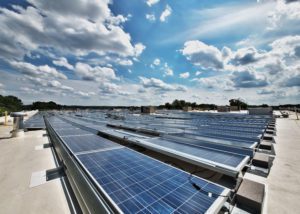As grid operators continue to establish or expand their smart grid strategies worldwide, many major commercial and industrial businesses are already setting plans to control their own energy futures. The announcement in April by global retail giant Walmart is a good example.
Their CEO said that by 2020 the company is targeting a 20% reduction in energy consumption, a 600% increase in the use of renewables, and the installation of rooftop solar panels on 1000 of its buildings. I’m betting that there are many other CEOs considering similar microgrid strategies right now, for the benefit of their bottom line and their corporate image. Hopefully, they are also considering the advantages of storing the energy they’ll be producing, and how they plan to implement such a system. By neglecting this part of their microgrid strategy, much of that locally generated ‘green’ energy could go to waste.
This is my third post on electrical energy storage systems (EESS) for onsite generation assets. My first post discussed the many benefits of storing energy onsite, including the ability to maximize self-consumption, get the most payback from demand response or flexible tariff programs, and provide a backup system to help ride through blackouts. My second post reviewed some key EESS features to look for, including the intelligence and communication capabilities necessary to effectively manage participation in smart grid programs, and a battery system that is efficient, flexible, and highly reliable. So now is a good time to talk about associated services you’ll want to take advantage of, before and after your new EESS system is installed.
Four easy steps to making energy storage a reality
Setting up your own microgrid can be a complex task, and that includes the proper selection and integration of an EESS to support it. That’s why you’ll want to work with a supplier that takes you through a logical set of service steps to achieve your energy storage goals in a fully tailored way. And the more of these steps that can be covered by a single vendor the simpler it will be for you.
First, you should expect the vendor to perform a complete audit of your facility. This will help accurately define the loads and generation assets you have, or are planning. In turn, this will help define the specific design requirements of the EESS, and the specific loads, processes, or areas that are supplied by stored energy when switched in.
At this point, a cross-functional project management team should be established to provide oversight and coordination at each stage.
Services will then be set up and scheduled to deliver the full installation and commissioning of the EESS. You should expect this to be done as quickly as possible with no disruption to your operations. And, of course, it should be done in compliance with all local and national safety standards.
You should also expect a comprehensive range of support services to ensure your system runs, and continues to run, at full performance for a long time to come.
Going deeper, to reach higher
Beyond the main benefits of energy storage in greatly extending the flexibility and value of your onsite generation assets, an intelligent and connected EESS also opens the door to many other enhanced services. Your new communication links to the smart grid, and to all of your facilities energy assets, can be further leveraged in powerful ways.
For example, there are a number of subscription-based energy management services that can help you analyze your energy consumption, and production, in financial terms. Typically a cloud-hosted web portal, this kind of application will automatically access and convert the historical energy profile data from your system, making it easy for your accounting team to calculate cost savings, month-to-month, and to perform energy cost forecasting.. It will also estimate and validate the return on investment for any energy-related equipment upgrades. Some of these offers also provide equivalent emissions reporting, to help you set and track against environmental goals.
Asset management applications can also take advantage of the energy data from your EESS solution to support energy tracking for each building as well as augmenting equipment monitoring, reporting, and maintenance scheduling.
If you’re participating in a demand-response program with your energy supplier, there are consulting services that will help you choose the most remunerative DR programs to participate in, and optimize your EPSS to leverage the most flexibility from your energy storage and loads. If you’re in a region where there is an open, competitive energy market, you can look for energy arbitrage services that will help you dynamically compare market pricing and make the best decisions on energy purchases and sales.
Finally, you should view your microgrid and EESS as one part in a larger, holistic effort to continuously improve energy efficiency and reliability. With an energy intelligence system in place, a wide range of consulting and support services can help you expand your energy management strategies to include further optimizing your energy bills, discovering and reducing energy waste, and isolating power reliability risks.
Ultimately, with the right EESS system and supporting services you’ll go well beyond mobilizing and monetizing your energy resources on the smart grid. You will have taken the first steps toward springboarding your business into the rarified class of global energy efficiency leaders.



Conversation
Having read this article, it is really a success having this electrical energy storage system because lots of useful benefits you can get from it.
well written article, we design and install ESS and the savings offered by a well designed system can be amazing. The most important is to NOT speak with a sales person, but an application or energy engineer to get the truth about the right system to meet your needs, not the one they get paid the most for.
We have enjoyed Schneider’s offering in the small commercial and residential market. Their products (Conext XW+ line) give our installations great form not just great function.